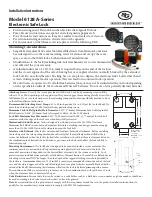
Before You Install
Your 6128 A-Series Lock was most likely shipped with the keypad and keypad extension connected to the lock
cables to allow for pre-installation testing. If your lock does not have cables already connected to the keypad
and keypad extension, temporarily connect them now as shown in these instructions. You should install fresh
batteries in the keypad (S&G recommends Duracell® alkaline batteries) and check the function of the lock prior
to installation by pressing 10101010# and observing the lock bolt retract, then extend 6 seconds later. After
this check, disconnect the cables from the extension base and keypad by pulling on the connectors (NOT on
the cables themselves). The installer should wear a properly grounded ESD wrist strap while working with lock
cables and components to avoid ESD damage.
1. Remove the existing lock (if present). The mounting plate should be smooth and
flat, with ¼-20 (M6) mounting screw holes. The wire channel (spindle hole) must
have a diameter of at least 0.312 inch (7,9 mm). The 6100 series can be mounted
right-hand, left-hand, vertical-up, or vertical-down without any modifications or
adjustments.
2. Use a reamer or round file to remove any sharp edges from the wire channel (spindle
hole) that might damage the wire cable. Gently pull the connectors to ease the cables
through the hole. Pull 6” to 8” (15 to 20 cm) of cable to the front of the safe door.
Later in the installation, excess keypad extension cable will be pulled back inside the
safe door. Make sure cables are not crimped or stressed at any point.
3. Using two of the ¼-20 (or M6) screws in the kit, loosely attach the lock body to the
safe’s mounting plate. This is just to hold it in place during cable attachments to the
keypad and keypad extension. Be very careful to avoid crushing or crimping the
cables. Note the black/red/green wire bundle. This is for the bolt position indicator,
a dry contact switch (200 VDC, 0.5 amp max.) The black wire is common, the green
wire completes a circuit to the black wire when the lock bolt is retracted, and the red
wire completes a circuit to the black wire when the lock bolt is extended. The BPI
can be used to trigger any switch-activated device.
Note
the blue wire loop. This is the secure loop, a closed circuit that may be used in
applications requiring switches or other devices to signal the lock that boltwork is
thrown, the door is closed, or some other action has taken place. The lock bolt will
NOT retract if the circuit formed by the blue wire loop is open. Both sets of wires
should be bundled and placed where they will not interfere with moving boltwork
components if not used.
4. Remove the lock mounting screws so you can carefully pull the excess extension
base cable inside. It is important to make sure the keypad and extension cables are
within the recessed channels underneath the lock case before the case is securely
attached by the three mounting screws. Once placed in the most convenient channel,
each cable should be protected underneath the case by a self-adhesive foam or vinyl
pad. It is very important that cables are not folded, crimped, or crushed beneath the
lock case. There are four sets of wires that must be carefully placed where they will
not interfere with or be damaged by moving boltwork. These are:
• excess keypad cable (4-conductor)
• secure loop (1-conductor blue wire)
• bolt position indicator (BPI) wires
• excess keypad extension cable (5-conductor) 2





